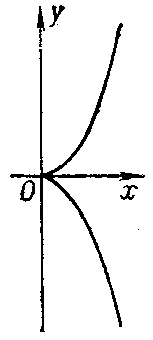Difference between revisions of "Semi-cubic parabola"
From Encyclopedia of Mathematics
(Importing text file) |
(historical note, from Neil parabola) |
||
| (One intermediate revision by one other user not shown) | |||
| Line 1: | Line 1: | ||
| + | {{TEX|done}}{{MSC|53A04}} | ||
| + | |||
A third-order algebraic curve in the plane whose equation in Cartesian coordinates is | A third-order algebraic curve in the plane whose equation in Cartesian coordinates is | ||
| − | + | $$y=ax^{3/2}.$$ | |
The origin is a [[Cusp(2)|cusp]] (see Fig.). The length of the arc from the origin equals | The origin is a [[Cusp(2)|cusp]] (see Fig.). The length of the arc from the origin equals | ||
| − | + | $$l=\frac{1}{27a^2}[(4+9a^2x)^{2/3}-8];$$ | |
and the curvature equals | and the curvature equals | ||
| − | + | $$k=\frac{6a}{\sqrt x(4+9a^2x)^{3/2}}.$$ | |
| − | A semi-cubic parabola is sometimes called a Neil parabola. | + | A semi-cubic parabola is sometimes called a Neil parabola, after W. Neil who found its arc length in 1657. |
<img style="border:1px solid;" src="https://www.encyclopediaofmath.org/legacyimages/common_img/s084040a.gif" /> | <img style="border:1px solid;" src="https://www.encyclopediaofmath.org/legacyimages/common_img/s084040a.gif" /> | ||
| Line 18: | Line 20: | ||
====References==== | ====References==== | ||
| − | <table><TR><TD valign="top">[1]</TD> <TD valign="top"> A.A. Savelov, "Planar curves" , Moscow (1960) (In Russian)</TD></TR><TR><TD valign="top">[2]</TD> <TD valign="top"> A.S. Smogorzhevskii, E.S. Stolova, "Handbook of the theory of planar curves of the third order" , Moscow (1961) (In Russian)</TD></TR></table> | + | <table> |
| + | <TR><TD valign="top">[1]</TD> <TD valign="top"> A.A. Savelov, "Planar curves" , Moscow (1960) (In Russian)</TD></TR> | ||
| + | <TR><TD valign="top">[2]</TD> <TD valign="top"> A.S. Smogorzhevskii, E.S. Stolova, "Handbook of the theory of planar curves of the third order" , Moscow (1961) (In Russian)</TD></TR> | ||
| + | </table> | ||
| Line 26: | Line 31: | ||
====References==== | ====References==== | ||
| − | <table><TR><TD valign="top">[a1]</TD> <TD valign="top"> J.D. Lawrence, "A catalog of special plane curves" , Dover, reprint (1972)</TD></TR><TR><TD valign="top">[a2]</TD> <TD valign="top"> F. Gomes Teixeira, "Traité des courbes" , '''1–3''' , Chelsea, reprint (1971)</TD></TR></table> | + | <table> |
| + | <TR><TD valign="top">[a1]</TD> <TD valign="top"> J.D. Lawrence, "A catalog of special plane curves" , Dover, reprint (1972)</TD></TR> | ||
| + | <TR><TD valign="top">[a2]</TD> <TD valign="top"> F. Gomes Teixeira, "Traité des courbes" , '''1–3''' , Chelsea, reprint (1971)</TD></TR> | ||
| + | </table> | ||
Latest revision as of 16:04, 16 April 2018
2020 Mathematics Subject Classification: Primary: 53A04 [MSN][ZBL]
A third-order algebraic curve in the plane whose equation in Cartesian coordinates is
$$y=ax^{3/2}.$$
The origin is a cusp (see Fig.). The length of the arc from the origin equals
$$l=\frac{1}{27a^2}[(4+9a^2x)^{2/3}-8];$$
and the curvature equals
$$k=\frac{6a}{\sqrt x(4+9a^2x)^{3/2}}.$$
A semi-cubic parabola is sometimes called a Neil parabola, after W. Neil who found its arc length in 1657.

Figure: s084040a
References
| [1] | A.A. Savelov, "Planar curves" , Moscow (1960) (In Russian) |
| [2] | A.S. Smogorzhevskii, E.S. Stolova, "Handbook of the theory of planar curves of the third order" , Moscow (1961) (In Russian) |
Comments
References
| [a1] | J.D. Lawrence, "A catalog of special plane curves" , Dover, reprint (1972) |
| [a2] | F. Gomes Teixeira, "Traité des courbes" , 1–3 , Chelsea, reprint (1971) |
How to Cite This Entry:
Semi-cubic parabola. Encyclopedia of Mathematics. URL: http://encyclopediaofmath.org/index.php?title=Semi-cubic_parabola&oldid=13302
Semi-cubic parabola. Encyclopedia of Mathematics. URL: http://encyclopediaofmath.org/index.php?title=Semi-cubic_parabola&oldid=13302
This article was adapted from an original article by D.D. Sokolov (originator), which appeared in Encyclopedia of Mathematics - ISBN 1402006098. See original article